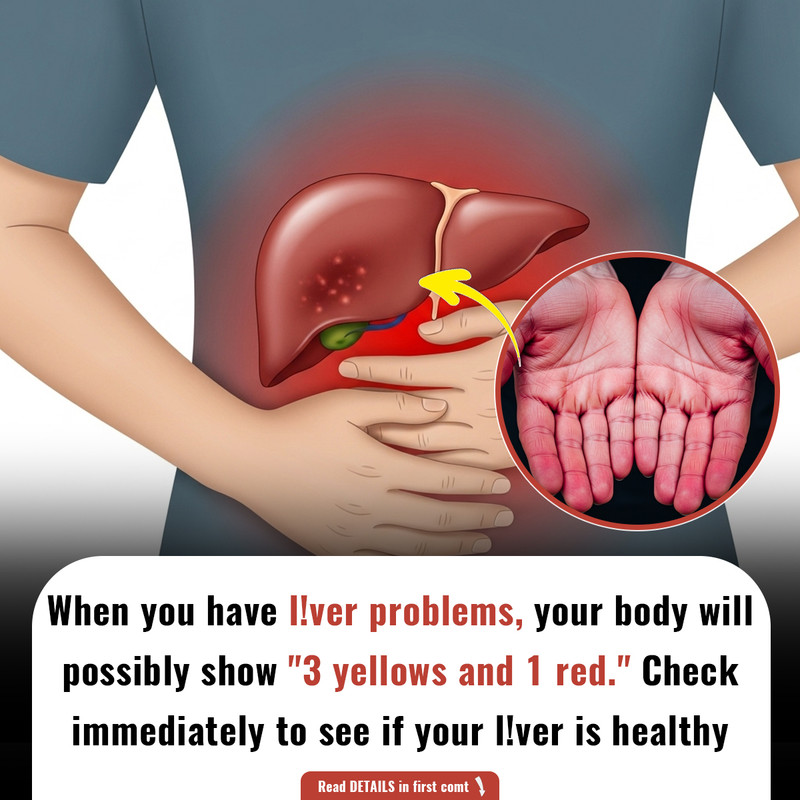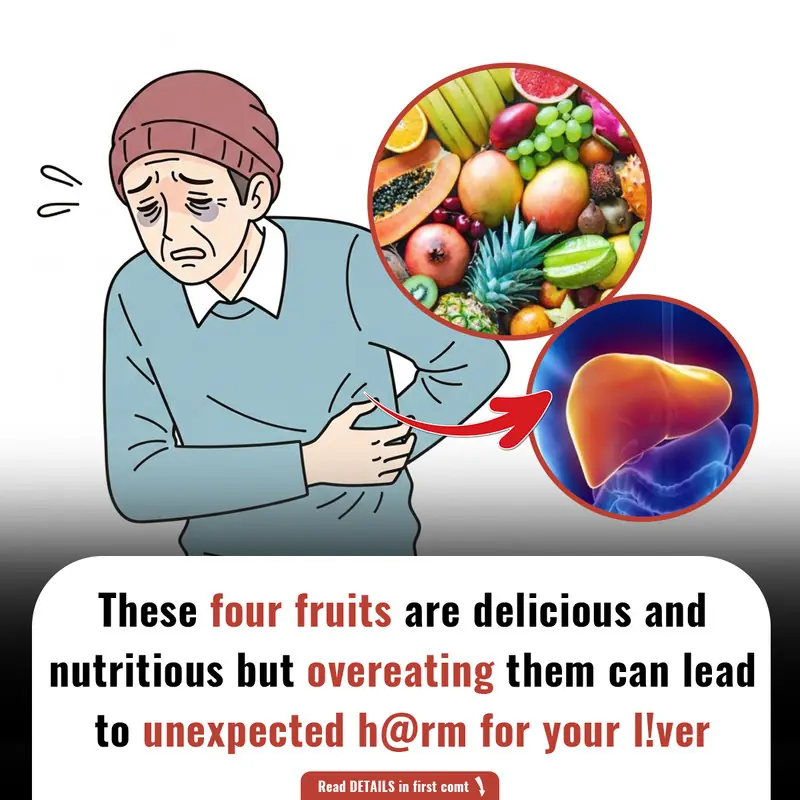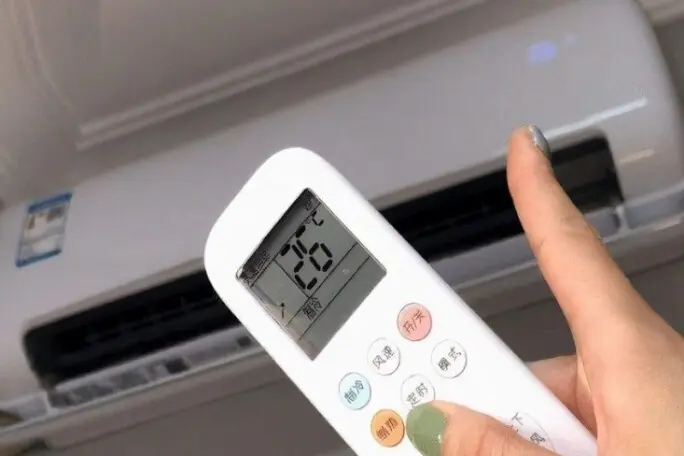
3 Yellow Signs and 1 Red Flag: Check Now to See If Your Liver is Healthy

The liver is an essential organ in our body, responsible for performing numerous vital functions such as detoxification, protein production, and nutrient metabolism. Because of its critical role, it’s important to monitor your liver health and be aware of any potential issues. Unfortunately, liver problems often develop gradually, and by the time symptoms appear, the liver may have already been significantly damaged.
One of the most common ways the body signals liver distress is through the manifestation of certain symptoms. In this article, we will focus on the "3 yellow signs and 1 red flag" that may indicate liver problems. Recognizing these signs early can help you take proactive steps to protect your health and get the right treatment.
1. Dark Yellow Urine: A Sign of Bilirubin Build-up
Urine is typically light yellow, but when the liver is struggling to filter out waste products, the urine can become dark yellow, amber, or even brown. This change in color can occur because the liver is unable to process bilirubin – a yellow compound produced during the breakdown of red blood cells. When the liver is functioning properly, bilirubin is excreted in the stool. However, if the liver is impaired, bilirubin accumulates in the blood, leading to its excretion through the kidneys, causing urine to darken.
If you notice your urine becoming darker than usual, particularly if it persists, it is important to consider liver health. It is often accompanied by other symptoms like yellowing of the skin or eyes, so pay attention to these signs as a potential indicator of liver dysfunction.
2. Yellowing of the Eyes (Jaundice): A Clear Warning Sign
The yellowing of the whites of the eyes, also known as jaundice, is one of the most noticeable and reliable signs of liver problems. When the liver is not functioning properly, bilirubin builds up in the bloodstream, causing a yellowish tint to the skin and the eyes. Normally, the liver processes and removes bilirubin, but when it becomes overwhelmed or damaged, it cannot perform this task effectively, leading to jaundice.
Jaundice doesn’t just affect the eyes; it can also appear on the skin, especially around the face, palms, and soles of the feet. If you notice that your eyes or skin appear yellowish, this is a signal that your liver may not be processing waste products as efficiently as it should. Jaundice is a red flag and requires immediate attention from a healthcare professional for a proper diagnosis and treatment.
3. Yellowing of the Skin: What It Means for Your Liver Health
While yellowing of the eyes is the most common sign of jaundice, the skin can also turn yellow when bilirubin builds up in the body. This can be particularly evident in the face, hands, and feet. The severity of jaundice varies depending on how much bilirubin is in the bloodstream and how badly the liver is damaged.
If your skin begins to show a yellow tint, particularly if it’s accompanied by other symptoms like fatigue, abdominal pain, or nausea, it’s crucial to see a doctor. Jaundice can indicate conditions such as hepatitis, cirrhosis, or liver failure, which require urgent medical care to prevent further damage and complications.
4. Red Tongue: An Indicator of Liver Dysfunction
While yellowing of the skin and eyes are more commonly associated with liver disease, one often-overlooked sign is a red tongue. A tongue that appears bright red, particularly without any white coating, can be a sign that the liver is not functioning properly. When the liver is impaired, it is less able to filter out toxins, which can lead to a buildup of harmful substances in the body. These substances can accumulate in the tongue and cause it to appear redder than normal.
In addition to the red color, other signs on the tongue can include swelling, sores, or a strange taste in the mouth. If you notice these symptoms along with other liver-related signs, it’s essential to seek medical advice as soon as possible.
Understanding Liver Health: How to Take Action
It’s crucial to understand that while these "3 yellow signs and 1 red flag" can indicate liver problems, they are not definitive proof of liver disease. Many conditions, from mild liver conditions to more serious issues like liver failure, can cause these symptoms. Therefore, it’s important to take these signs seriously and consult a healthcare provider for further investigation.
A blood test to check liver enzymes, bilirubin levels, and other indicators can help confirm whether your liver is functioning properly. Your doctor may also recommend imaging tests such as an ultrasound or CT scan to assess the liver’s condition.
Conclusion
Liver health is often overlooked until significant damage occurs, but recognizing the warning signs early can prevent further complications. The "3 yellow signs and 1 red flag" provide critical clues that can help you detect liver problems before they become severe. If you notice any of these signs—dark yellow urine, yellowing of the eyes or skin, or a red tongue—don’t ignore them. Seek medical attention promptly to ensure that your liver remains healthy and to prevent any potential long-term health issues.
News in the same category


Doctor reveals two little-known signs of skin cancer that everyone misses
Along with the more obvious signs such as changes in moles, these hidden symptoms should be taken seriously.

Why You Should Unplug the Hotel TV Immediately After Checking In

Doctor warns of alarming health risks of sleeping with a fan on during a heatwave
As the heatwave looms and temperatures continue to rise, it is essential for individuals to consider the hidden health risks associated with sleeping with a fan on.

How to Keep Ripe Avocados Fresh and Creamy for Days

Secret cleaning tip: how to keep your floors clean and dust-free for seven days

How to Tell the Difference Between Naturally Ripened Durian and Chemical-Ripened Ones

3 Simple Items That Help Save Electricity for Your Fridge

The Silent D@nger: 4 'Healthy' Vegetables That Can H@rm Your Kidneys

Top 4 Fruits to Limit for a Healthier Liver

Why Smart People Never Set Their Air Conditioner to 26°C at Night

How to Position Your TV in the Living Room for Optimal Health and Wealth

Hidden D@ngers on Your Dinner Plate: 3 Common Vegetables That May Be D@m@ging Your Digestive Health

Doctors warn just one glass of this drink a day could increase risk of being diagnosed with cancer
A doctor in New York City has discovered a worrying trend between a drink almost two-thirds of Americans enjoy and an aggressive cancer.

Many Confuse This Plant with a Weed, But It’s Actually Full of Surprising Health Benefits
From providing omega-3 fatty acids to supporting heart, bone, and kidney health, purslane offers a wide range of benefits.

Doctor reveals the one sound people make that means they have under 24 hours left to live
This phenomenon is most commonly observed as the person drifts in and out of consciousness, and their breathing becomes more labored.

Don't Underestimate This Common Feature of Rice Cookers: It Could Be Harmful to Your Health

Smart People Know This Trick: Save Up to 50% on Your Monthly Electricity Bill by Adjusting Your Air Conditioner

Why Smart People Often Insert a Key into the Door When Sleeping: A Simple Habit with Big Benefits
News Post

DIY 3 Seed Drink For Losing Weight Fast: Natural, Effective, and Easy to Make
By combining cumin, fennel, flaxseeds, carom seeds, and ginger, you can support your body’s natural fat-burning processes, improve digestion, and reduce bloating. This natural remedy is affordable, easy to make, and free from harmful chemicals.

4 Common Meat Thawing Mistakes That Could Put Your Family's Health at Risk

Ancient Indian Hair Oil Remedy: Get Crazy Hair Growth Naturally
The ingredients in this ancient Indian remedy work together to nourish and revitalize the scalp, providing your hair with the nutrients it needs to grow strong, thick, and beautiful.

Homemade Neem Gel for Clear and Flawless Skin: Your Ultimate Natural Solution for Acne, Blemishes, and Aging
Incorporating neem gel into your skincare routine is a simple and effective way to achieve clear, healthy, and radiant skin.

Doctor reveals two little-known signs of skin cancer that everyone misses
Along with the more obvious signs such as changes in moles, these hidden symptoms should be taken seriously.

Why You Should Unplug the Hotel TV Immediately After Checking In

Doctor warns of alarming health risks of sleeping with a fan on during a heatwave
As the heatwave looms and temperatures continue to rise, it is essential for individuals to consider the hidden health risks associated with sleeping with a fan on.

How to Keep Ripe Avocados Fresh and Creamy for Days

Secret cleaning tip: how to keep your floors clean and dust-free for seven days

How to Tell the Difference Between Naturally Ripened Durian and Chemical-Ripened Ones

Homemade Eye Roll To Get Rid Of Dark Circles: The Ultimate Natural Remedy for Dark Circles
The homemade eye roll remedy we’ve shared today combines the soothing, brightening, and hydrating powers of olive oil, aloe vera, lemon zest, and raw milk to help reduce puffiness, lighten dark circles, and restore the vitality of the delicate skin arou

3 Simple Items That Help Save Electricity for Your Fridge

The Silent D@nger: 4 'Healthy' Vegetables That Can H@rm Your Kidneys

Top 4 Fruits to Limit for a Healthier Liver

Natural Remedy to Reverse Grey Hair: Unlocking the Secrets to Rejuvenate Your Hair Color
This DIY remedy offers a holistic approach to hair health-nourishing from within and the outside.

5 Powerful Ways to Use Vaseline for Anti-Aging: Natural Remedies for Smoother, Wrinkle-Free Skin
Try these 5 homemade Vaseline treatments today, and enjoy youthful, wrinkle-free, and radiant skin with the power of nature!

Erase Wrinkles and Achieve Glowing Skin Naturally: The Ultimate Banana Face Pack for Youthful Radiance
By incorporating natural ingredients like banana peels, rice, cornstarch, and lemon juice, you can nourish your skin and achieve a radiant, youthful complexion without harsh chemicals or expensive treatments.

Why Smart People Never Set Their Air Conditioner to 26°C at Night
